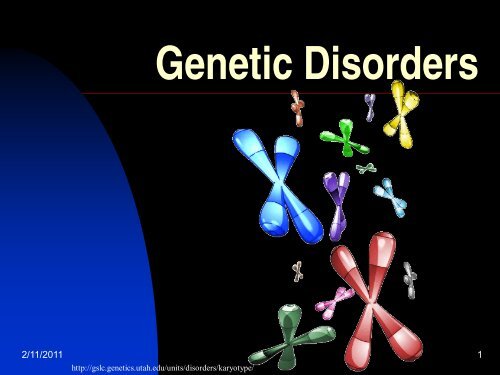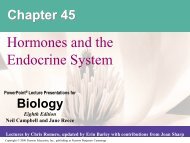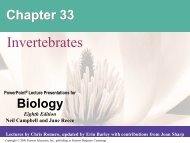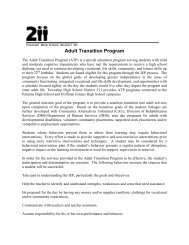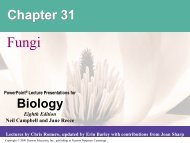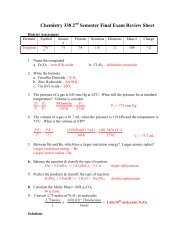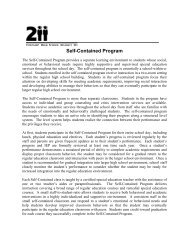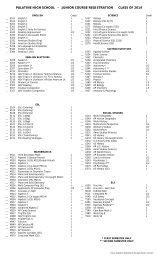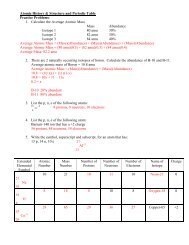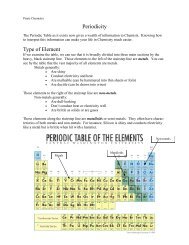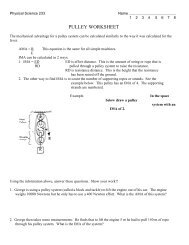Genetic Disorders PPT
Genetic Disorders PPT
Genetic Disorders PPT
Create successful ePaper yourself
Turn your PDF publications into a flip-book with our unique Google optimized e-Paper software.
<strong>Genetic</strong> <strong>Disorders</strong><br />
2/11/2011 1<br />
http://gslc.genetics.utah.edu/units/disorders/karyotype/
Causes<br />
• A change in a gene called a<br />
“mutation”<br />
• A mutated gene = nonfunctional<br />
protein or no protein at all<br />
2/11/2011 2
What alleles are most<br />
often affected?<br />
• Most often recessive alleles (so not<br />
expressed in heterozygous<br />
individuals)<br />
• Dominant alleles (rare)<br />
2/11/2011 3
Characteristics<br />
• Inherited at moment of conception;<br />
programmed into one’s genes<br />
• Sometimes treatable<br />
2/11/2011 4
<strong>Genetic</strong> disorders<br />
caused by dominant or<br />
recessive alleles<br />
2/11/2011 5
PKU (Phenylketonuria)<br />
• (*most common among people<br />
whose ancestors came from<br />
Norway or Sweden)<br />
2/11/2011 6
PKU cause<br />
• Recessive disorder<br />
• Individuals lack an enzyme that<br />
converts one amino acid,<br />
phenylalanine, to a different aa,<br />
tyrosine<br />
2/11/2011 7
PKU results<br />
• Phenylalanine cannot be broken<br />
down<br />
• Its by-products accumulate in body<br />
and result in severe damage to<br />
CNS<br />
• Mental retardation occurs<br />
2/11/2011 8
Treatment<br />
• PKU test performed on newborns<br />
• PKU infants given diet low in<br />
phenylalanine until brains are fully<br />
developed<br />
2/11/2011 9
New problem created<br />
• When females who are<br />
homozygous recessive for PKU<br />
become pregnant<br />
• High levels of phenylalanine in<br />
blood can damage fetus<br />
• Must avoid diet foods sweetened<br />
with artificial sweetener containing<br />
phenylalanine (diet pop, etc.)<br />
2/11/2011 10
Cystic fibrosis<br />
(CF)<br />
• Autosomal Recessive<br />
• Most common genetic disorder<br />
among white Americans<br />
• (1 in 20 w. Amer. Carries recessive<br />
allele on chromo. #7)<br />
• (1 in 2500 children born to w.<br />
Amer. Inherit disorder)<br />
2/11/2011 11
CF cause<br />
• Defective protein in plasma<br />
membrane<br />
• (membrane channels for<br />
transporting Cl- ions)<br />
2/11/2011 12
CF result<br />
• Accumulation of mucus in lungs<br />
and digestive tract (favoring<br />
bacterial infections)<br />
• Difficulty breathing and digesting<br />
food<br />
2/11/2011 13
CF treatment<br />
• Physical therapy, special diets,<br />
new drug therapies have raised<br />
avg. life expectancies of CF<br />
patients<br />
• Possibility of gene transfer?<br />
2/11/2011 14
Tay-Sachs Disease<br />
• Autosomal Recessive<br />
• Causes progressive destruction of the<br />
CNS<br />
• Caused by the absence of an enzyme<br />
called hexosaminidase A (Hex-A)<br />
• Without this enzyme the GM2, a lipid<br />
called ganglioside, accumulates,<br />
especially in the cells of the brain,<br />
causing a destructive process in the<br />
fetus.<br />
2/11/2011 15
Tay-Sachs Disease Cont’d<br />
• The disease is not apparent until the<br />
child is several months old.<br />
• By the age of three or four, the CNS<br />
is greatly affected and the body<br />
cannot support normal functions<br />
ending in death by the age of five.<br />
2/11/2011 16
Tay-Sachs Disease Cont’d<br />
• Slow development, loss of peripheral<br />
vision, and abnormal startle response<br />
• By the age of two most children have<br />
seizures and diminishing mental function.<br />
• Loss of skills – eventually can’t crawl, turn<br />
over, sit, or reach out.<br />
• Increasing loss of coordination,<br />
progressive inability to swallow, and<br />
breathing difficulties<br />
• Eventually child becomes blind, mentally<br />
retarded, paralyzed, and non-responsive<br />
to his or her environment.<br />
2/11/2011 17
Tay-Sachs Disease Cont’d<br />
• Currently there is no cure<br />
• Active research is occurring<br />
• Replacement therapy for Hex-A is<br />
being explored<br />
• Bone marrow transplants have been<br />
attempted but unsuccessful<br />
2/11/2011 18
Huntington’s Disease<br />
• Neurological disease<br />
• Autosomal Dominant<br />
• No current cure or effective treatment<br />
• Causes gradual physical, emotional and<br />
cognitive deterioration.<br />
• Symptoms – involuntary jerking movements<br />
of the limbs, face, and trunk; increasing<br />
difficulty with communication, swallowing,<br />
and walking; problems with planning,<br />
organization, and initiating, as well as<br />
personality change.<br />
2/11/2011 19
Huntington’s Disease<br />
• Disease normally strikes in the prime<br />
of life (age 30-45) and possibly earlier.<br />
2/11/2011 20
<strong>Genetic</strong> disorders<br />
caused by sex-linked<br />
genes (recessive)<br />
• 1) color blindness<br />
• 2) hemophilia<br />
2/11/2011 21
Birth Defects<br />
• A condition caused by an error in<br />
the chromosomal make-up on an<br />
individual<br />
2/11/2011 22
Causes<br />
• 1) Error in cell division:<br />
Chromosomes line up, but are not<br />
evenly divided during meiosis =<br />
nondisjunction<br />
RESULT? One too many<br />
(trisomy: 47 chromosomes) or<br />
one too few (monosomy: 45)<br />
chromosomes in a cell<br />
2/11/2011 23
Causes<br />
• 2) translocation: breakage of an<br />
arm of a chromosome – moves<br />
and connects elsewhere<br />
(1 in 500 egg or sperm cells)<br />
Translocation video<br />
2/11/2011 24
How are unusual #’s of<br />
chromosomes detected?<br />
• Karyotype:<br />
<br />
sample of cells obtained from an<br />
individual or fetus<br />
Metaphase chromosomes are<br />
photographed<br />
Chromosome pictures enlarged,<br />
cut apart, and arranged in pairs<br />
according to length and location of<br />
the centromere<br />
2/11/2011 25
2/11/2011 27
Results of abnormal # of<br />
chromosomes<br />
• Most disorders of chromosome #<br />
that occur in humans cause<br />
symptoms so severe that the<br />
developing fetus dies, often before<br />
the woman even knows she is<br />
pregnant<br />
2/11/2011 28
Down syndrome:<br />
trisomy 21<br />
• Result of trisomy<br />
(nondisjunction) or<br />
translocation<br />
• D.S. = 1 in 700 live births<br />
• Trisomy Video<br />
2/11/2011 29
Characteristics<br />
• Mental retardation<br />
• Short stature<br />
• Slanting fold of skin on upper eyelid<br />
2/11/2011 30<br />
http://gslc.genetics.utah.edu/units/disorders/karyotype/
Unusual #’s of sex<br />
chromosomes<br />
• XO, XXX, XXY<br />
• XYY<br />
2/11/2011 31
Turner syndrome XO<br />
• Females<br />
• 1/6000 live births<br />
• Absence of 2 nd sex chromosome<br />
• External female organs, small and<br />
nonfunctional ovaries, oviducts,<br />
and uterus<br />
• Don’t go thru puberty<br />
changes=infertile<br />
• Normal intelligence<br />
• Monosomy Video<br />
2/11/2011 32
Klinefelter’s syndrome<br />
XXY<br />
• Males<br />
• 1/1500 live births<br />
• Full life span, sterile,<br />
underdeveloped testes and<br />
prostate, no facial hair, breast<br />
development, large hands and<br />
feet, long arms and legs, slower to<br />
learn but not MR<br />
2/11/2011 33
Klinefelter’s syndrome<br />
XXY<br />
2/11/2011 34<br />
http://gslc.genetics.utah.edu/units/disorders/karyotype/
Diabetes Mellitus<br />
• Abnormally high blood glucose<br />
concentration<br />
• Autoimmune disorder where insulin<br />
(lowers blood sugar level)<br />
producing islet cells in pancreas<br />
die<br />
• May be caused by a disposition of<br />
genes to an autoimmune<br />
response—not really sure<br />
2/11/2011 35
Diabetes (con’d)<br />
• <strong>Genetic</strong> predisposition<br />
• Triggered by viral infection????<br />
• Type 1: onset during childhood,<br />
daily injections of insulin<br />
• Type 2: onset during adulthood,<br />
more common than 1 and less<br />
severe<br />
Often correlated with obesity<br />
2/11/2011 36
Spina Bifida<br />
• Not genetic defect, but birth defect<br />
• 1 out of 1,000 newborns<br />
• Results from failure of spine to<br />
close properly during 1 st month of<br />
pregnancy<br />
• Not lethal<br />
2/11/2011 37
Galactosemia<br />
• Rare genetic disorder<br />
• 2 recessive genes<br />
• Too much galactose in blood due<br />
to missing enzyme that converts<br />
galactose to glucose<br />
• Accumulation is a poison to body<br />
and can cause<br />
Kidney failure, cataracts, brain<br />
damage, enlarged liver<br />
2/11/2011 38
Galactosemia (con’d)<br />
• Diagnosis during 1 st week of life by<br />
blood test<br />
• Strict exclusion of<br />
lactose/galactose from diet<br />
2/11/2011 39
<strong>Genetic</strong> Counseling<br />
• 1) Determine probability of genetic<br />
diseases being carried and passed<br />
on to children<br />
Ex: pedigrees, chemical tests to<br />
determine carriers<br />
2/11/2011 40
<strong>Genetic</strong> Counseling<br />
• 2) Diagnose the presence of a<br />
genetic disorder in a fetus<br />
• Median income for genetic<br />
counselors with a master's degree<br />
and up to 5 years experience in<br />
2002 was $47,000 to $56,000.<br />
• (http://www.ornl.gov/sci/techresources/Human_Genome/medicine/genecounseling.<br />
shtml#1)<br />
• http://www.nsgc.org/careers/<br />
2/11/2011 41
Amniocentesis<br />
needle inserted into uterus and<br />
10 mL of amniotic fluid is<br />
extracted<br />
beginning of 14-16 week of preg.<br />
<strong>Genetic</strong> disorders detected from<br />
presence of certain chemicals<br />
Cells can be cultured and<br />
karyotyped<br />
2/11/2011 42


